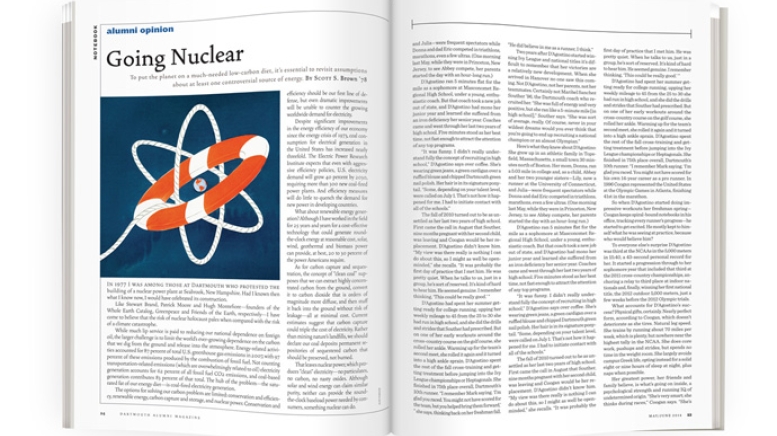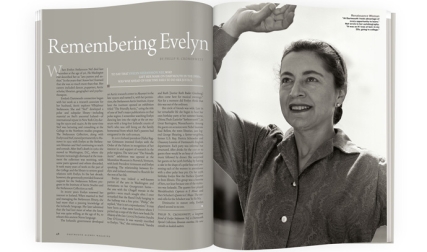In 1977 I was among those at Dartmouth who protested the building of a nuclear power plant at Seabrook, New Hampshire. Had I known then what I know now, I would have celebrated its construction.
Like Stewart Brand, Patrick Moore and Hugh Montefiore—founders of the Whole Earth Catalog, Greenpeace and Friends of the Earth, respectively—I have come to believe that the risk of nuclear holocaust pales when compared with the risk of a climate catastrophe.
While much lip service is paid to reducing our national dependence on foreign oil, the larger challenge is to limit the world’s ever-growing dependence on the carbon that we dig from the ground and release into the atmosphere. Energy-related activities accounted for 87 percent of total U.S. greenhouse gas emissions in 2007, with 97 percent of these emissions produced by the combustion of fossil fuel. Not counting transportation-related emissions (which are overwhelmingly related to oil) electricity generation accounts for 62 percent of all fossil fuel CO2 emissions, and coal-based generation contributes 83 percent of that total. The hub of the problem—the saturated fat of our energy diet—is coal-fired electricity generation.
The options for solving our carbon problem are limited: conservation and efficiency, renewable energy, carbon capture and storage, and nuclear power. Conservation and efficiency should be our first line of defense, but even dramatic improvements will be unable to counter the growing worldwide demand for electricity.
Despite significant improvements in the energy efficiency of our economy since the energy crisis of 1973, coal consumption for electrical generation in the United States has increased nearly threefold. The Electric Power Research Institute expects that even with aggressive efficiency policies, U.S. electricity demand will grow 40 percent by 2030, requiring more than 300 new coal-fired power plants. And efficiency measures will do little to quench the demand for new power in developing countries.
What about renewable energy generation? Although I have worked in the field for 25 years and yearn for a cost-effective technology that could generate round-the-clock energy at reasonable cost, solar, wind, geothermal and biomass power can provide, at best, 20 to 30 percent of the power Americans require.
As for carbon capture and sequestration, the concept of “clean coal” supposes that we can extract highly concentrated carbon from the ground, convert it to carbon dioxide that is orders of magnitude more diffuse, and then stuff it back into the ground without risk of leakage—all at minimal cost. Current estimates suggest that carbon capture could triple the cost of electricity. Rather than mining nature’s landfills, we should declare our coal deposits permanent repositories of sequestered carbon that should be preserved, not burned.
That leaves nuclear power, which produces “clean” electricity—no particulates, no carbon, no nasty oxides. Although solar and wind energy can claim similar purity, neither can provide the round-the-clock baseload power needed by consumers, something nuclear can do.
Only 75 miles from Dartmouth, the Vermont Yankee nuclear facility accounts for nearly three-quarters of that state’s generating capacity. Were Vermont to rely on coal-fired plants to generate the same amount of energy, its CO2 emissions would increase from zero to 4 million tons per year, almost three times the state’s allocation under the Regional Greenhouse Gas Initiative.
As Vermont Yankee faces a controversial relicensing process, there are legitimate concerns about its management, not about the cleanliness of its energy.
Worldwide, nuclear energy has avoided the production of more than 55 billion metric tons of CO2 during the past 30 years, enough to raise atmospheric concentrations by nearly 2 percent. The simple truth is this: Without nuclear power we have no hope of reaching U.S. or worldwide targets for greenhouse gas reductions. On the other hand, we could meet our U.S. goals and improve our energy security by doubling the U.S. fleet from 104 to 200 nuclear plants, a realistic goal across a 20-year period if we marshal our resources and establish federal authority for the siting and construction of plants.
What are the risks? The word “nuclear” conjures images of mushroom clouds and Chernobyl fires. Clear-eyed assessments of nuclear risks, however, paint a much different picture. Between 1969 and 2000, 27,000 people died in coal and natural gas industry accidents worldwide, but only 31 died in nuclear accidents (almost all at Chernobyl).
Each year U.S. coal plants produce 129 million tons of toxic ash, much of it contaminated with mercury, cadmium, chromium and uranium. In fact, U.S. coal plants release more uranium each year than all the uranium consumed by U.S. nuclear power plants. The total annual volume of high-level waste associated with an average-sized nuclear power plant would fit inside a large refrigerator.
France, which produces 80 percent of its electricity from nuclear power, reprocesses waste fuel rods into usable new fuel. The total accumulated waste from the past 30 years of nuclear energy generation in France is contained in a single room the size of a basketball arena. This does not mean we should be complacent about the very real risk of treating, transporting and securing our nuclear waste. But I have come to believe that the risk of global climate catastrophe during the next 200 years is far greater than the risk of radiation leaks from well-designed repositories.
We don’t have much time to act. Coal plants built today will run for generations, and the carbon they emit will linger far longer in our atmosphere. Unless we find the political will to alter the course of our energy industry, the future of our planet will be unlike the world we have known.
Scott S. Brown is CEO of New Energy Capital in Hanover and a former member of the advisory board of the National Renewable Energy Laboratory.




